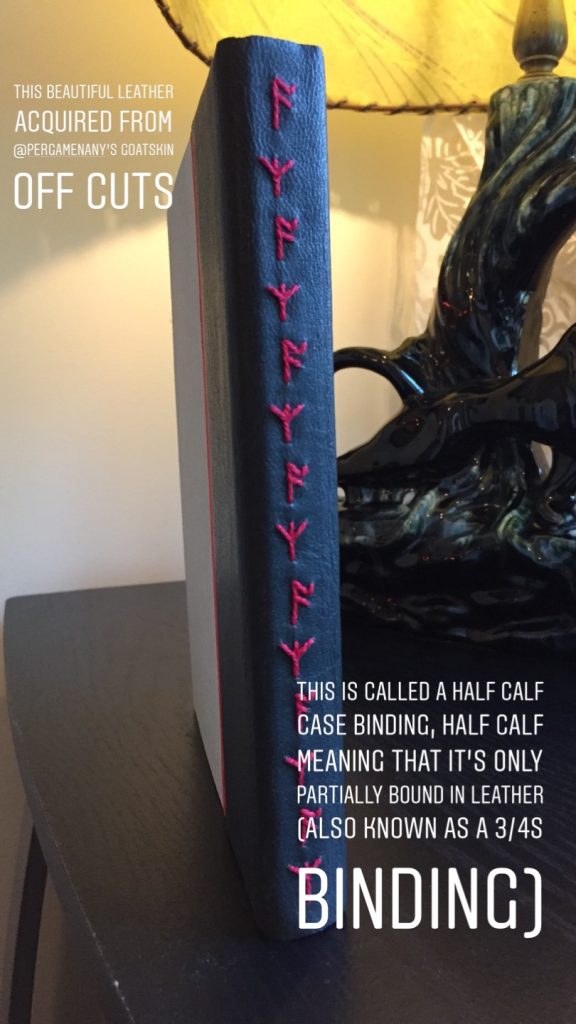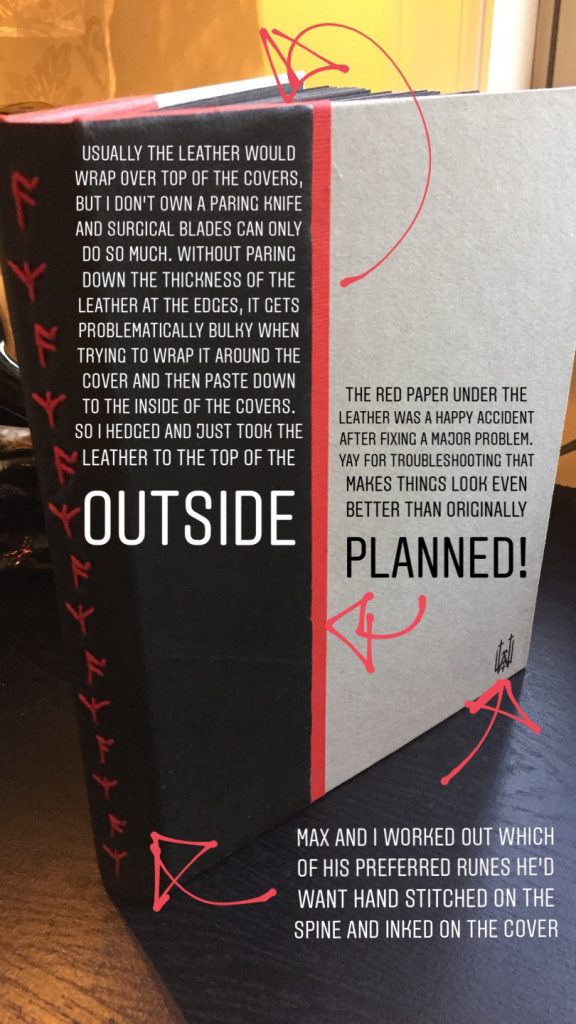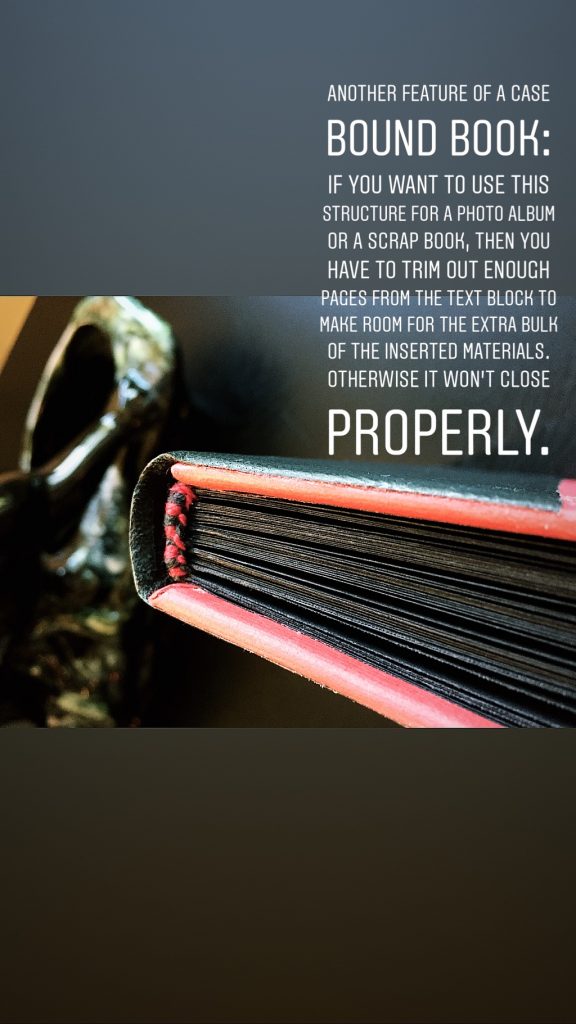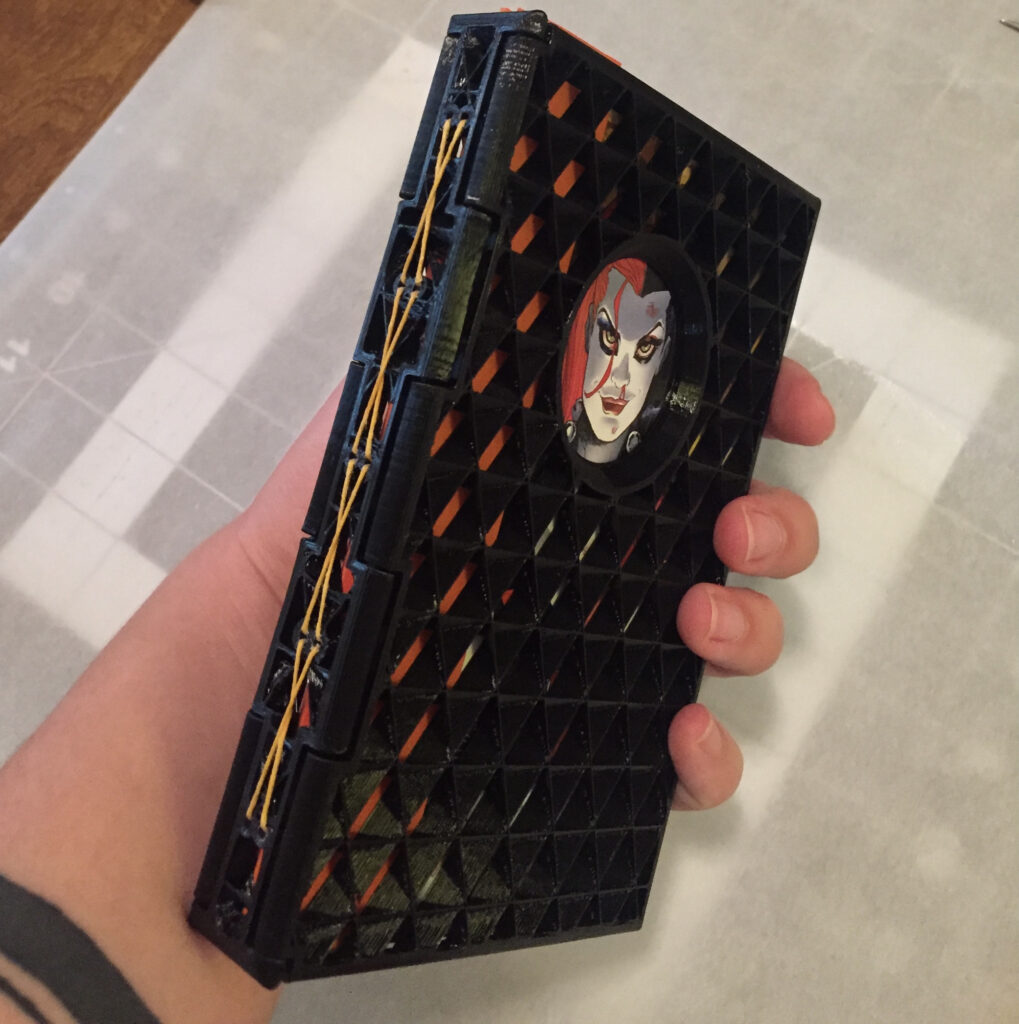
I worked with a 3-D printing enthusiast friend who wanted to incorporate 3-D printed structures into a bookbinding project. We worked together to determine two different binding styles that would work with two different cover designs for an Instructables.com contest he wished to enter. While he put together the 3-D printing components of the tutorial, I worked up the perfect and long-stitch binding instructions.
You can find the joint project here: https://www.instructables.com/Cryptex-Lock-Notebook/.
Creating that Instructable as a team made me want to put out tutorials on both perfect and long-stitch bindings individually. I’ve gotten round to the perfect binding Instructable (found here: https://www.instructables.com/Adhesive-Binding-Notebook/) and will eventually get to the long-stitch tutorial. Keep an eye on my Instructable.com account for that, and follow Echo Bravo’s account for more 3-D printing goodness!
]]>
In 2018, Max Shafer of Glenn’s Tattoo Service Inc. in Carrboro, NC asked me to work with him on a custom portfolio. After meeting several times to discuss what functionality and aesthetics he wished for in his book, we settled upon a half calf case binding.
Because Max is a tattooer, he needed a book that was durable and could contain photos. In order to achieve both of these and stay within Max’s desired aesthetic, I modified the case binding to make room for the photos. A standard photo album has a sturdy spine that’s as wide as the book might possibly get if every page were filled with pictures. In order to accommodate the bulk of adding photos and photo corners, I had to trim out parts of or entire signatures, making more room in the spine.
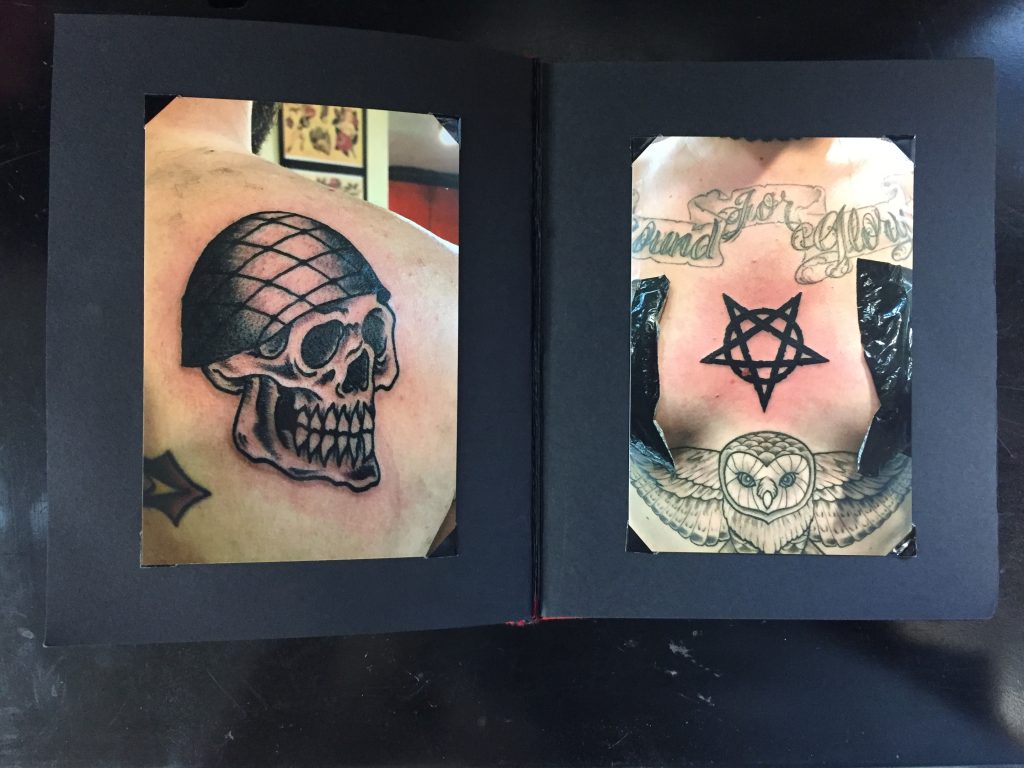
Example of a trimmed out signature 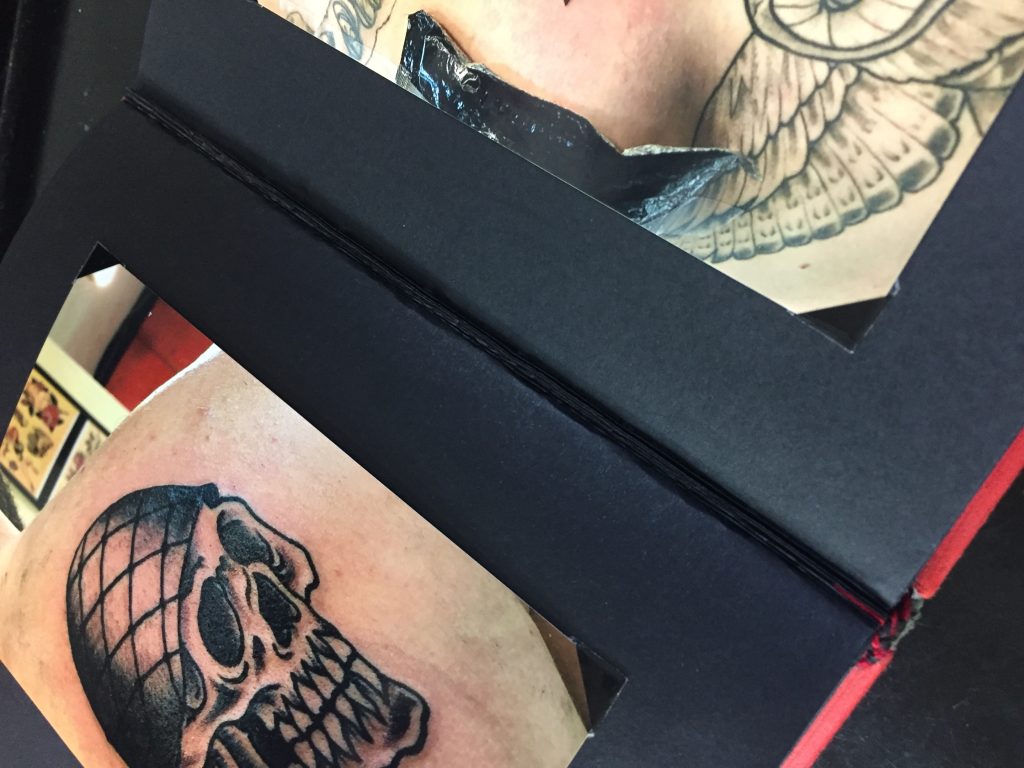
Closeup of the gutter showing the trimmed signature
Now, while this solved one problem, I also knew that the gutter of Max’s portfolio would still experience stress due not just to the bulk of the book and the removed signatures, but also due to the regular and none so gentle turning of the pages by his customers. With this in mind, I let Max know that I’d be back in after the portfolio had seen a month or so of use to doctor up any pages that proved weak. Sure enough, two pages needed a slip of paper pasted into the gutter to secure them back together.

The sigil on the cover of the book, the runes on the spine, and the runes covering the endpapers were selected by Max after I investigated with him which ones would represent the tone he was trying to set with his portfolio. The sigil I hand drew. The endpapers I hand lettered in red ink and painted in red acrylic. The runes I sewed into the leather prior to gluing it to the covers (black goat hide from Pergamena Leather & Parchment’s dyed leather scraps).
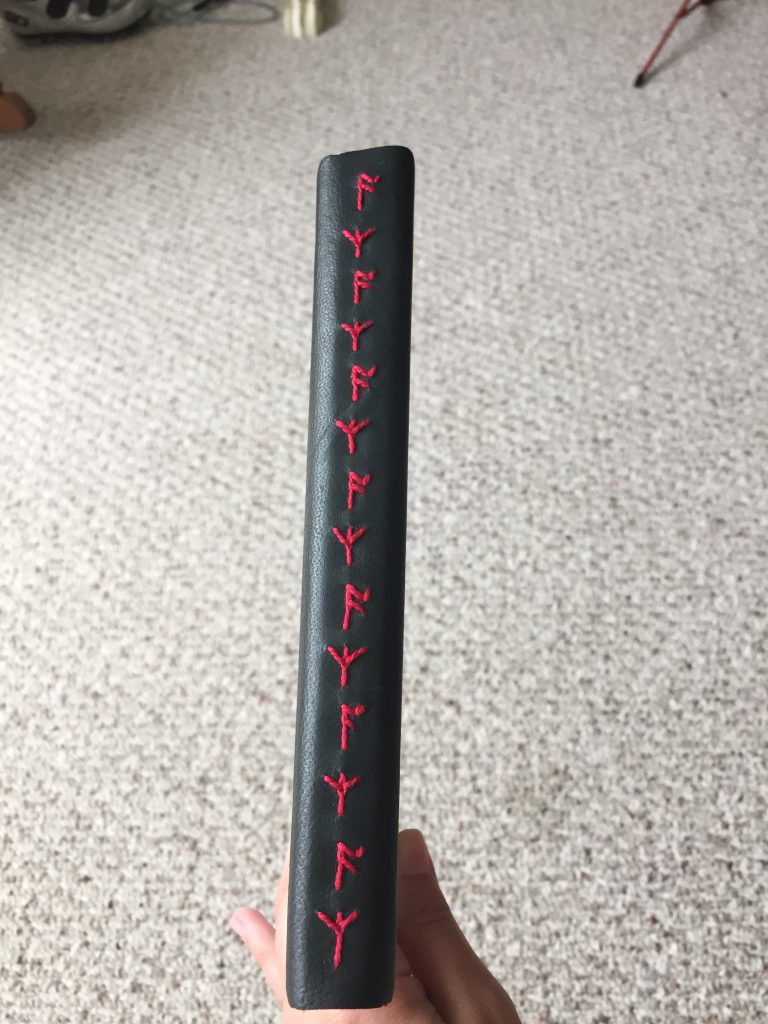
Embroidered spine 
Inked sigil 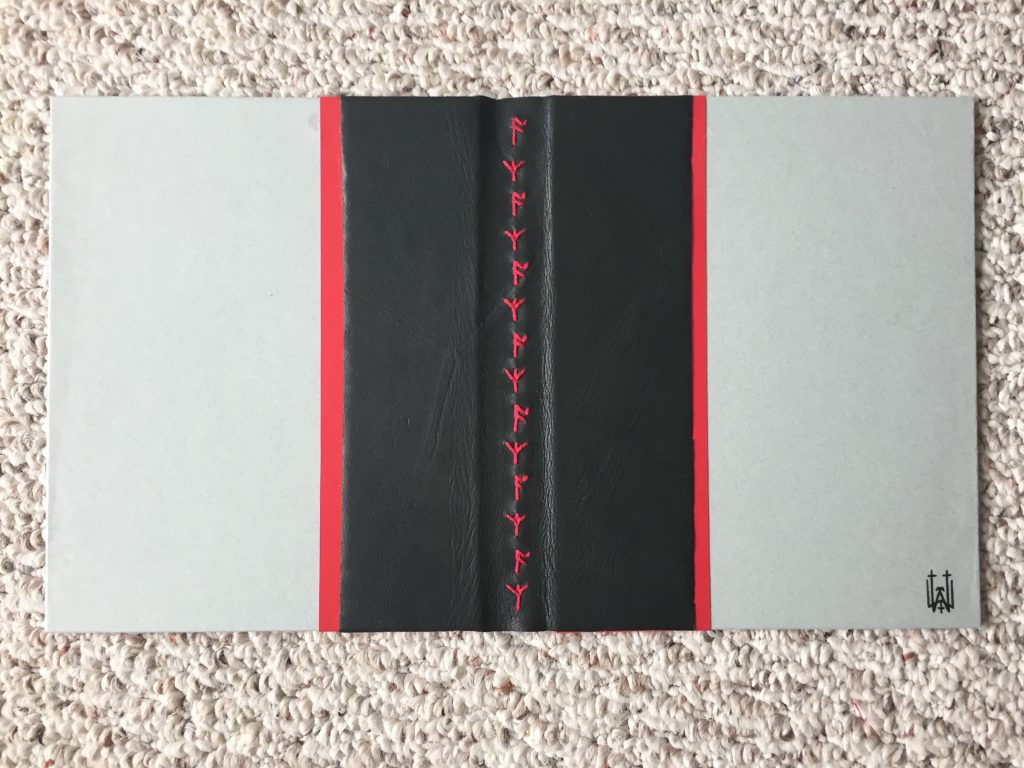
Attached spine and covers 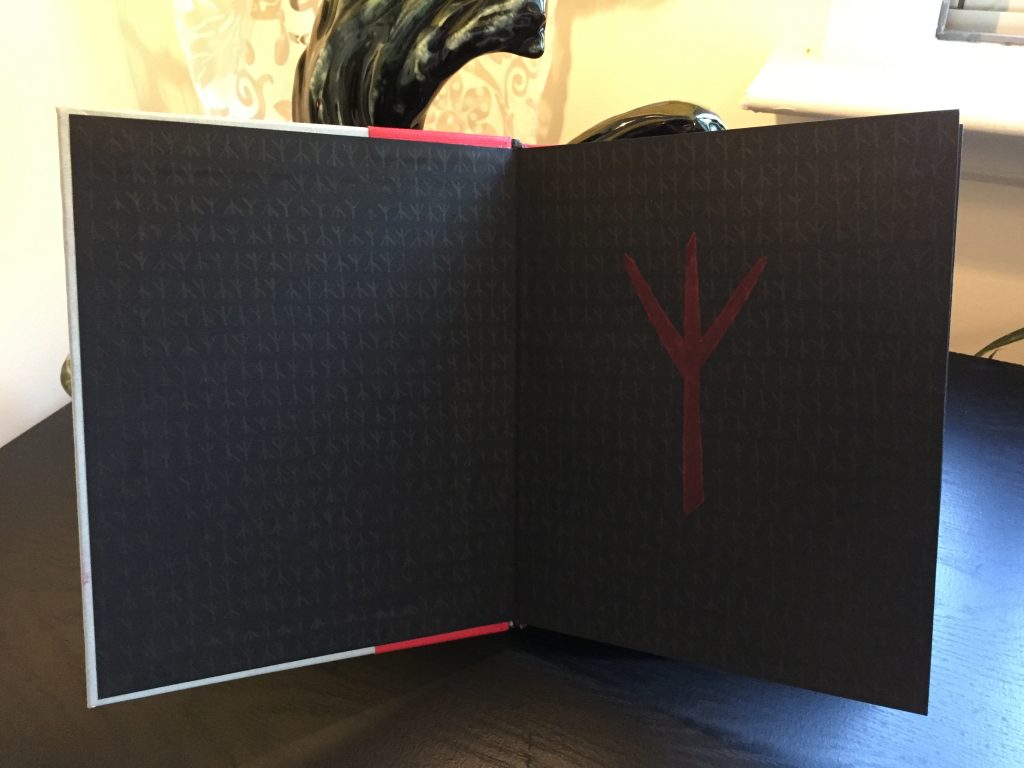
Front cover endpapers 
Back cover endpapers
To further stabilize the book, I also sewed beaded endbands into the head and tail of the spine. These are most often decorative in more modern books, simply pasted along the hidden space between the spine of the textblock and the spine of the covers; however, Max’s portfolio required the added stability of true endbands since the spine was already going to endure rough handling and pressure.
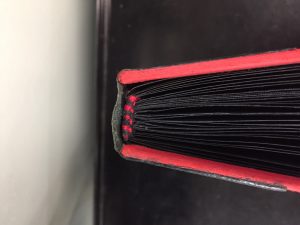
To see the portfolio in its home and in action, check out the following photo and video.
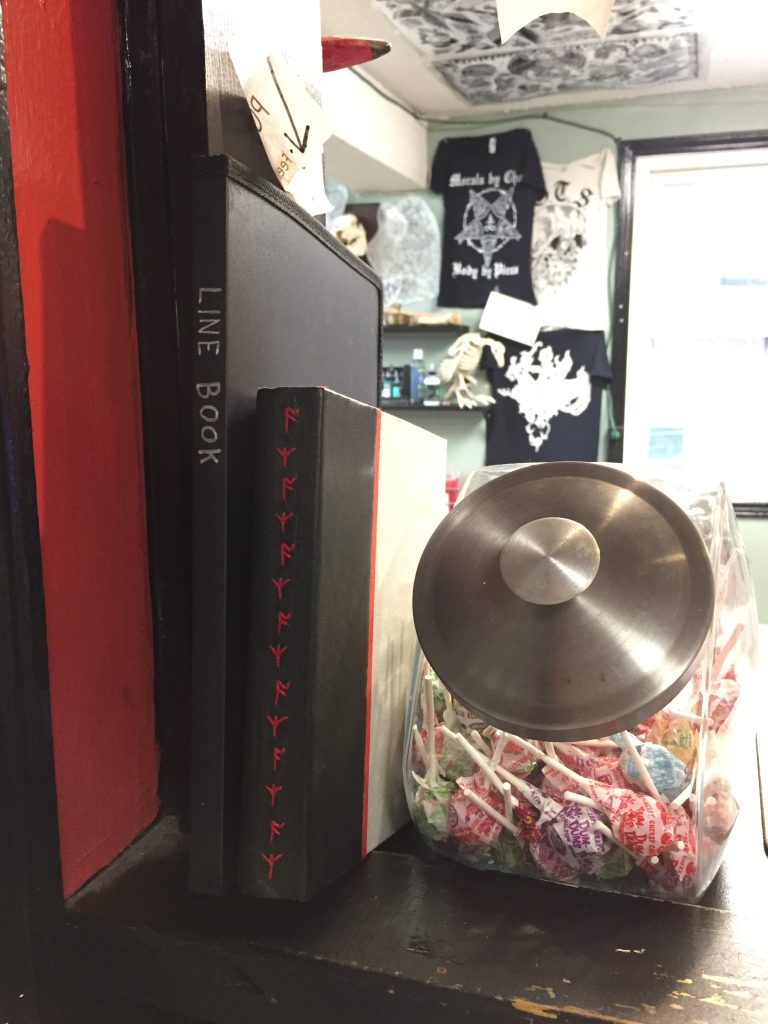
For a mini photo tour of the book, check out the following gallery.

Front cover 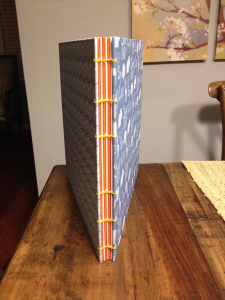
Spine 
First page with hand lettered name and birthday
The virtue of the Coptic stitch binding is that it lies flat, so it’s ideal for writing in, though it does provide a challenge if you want to use it as a photo album because there isn’t much room for the spine to expand. To see the work around for this, check out my blog post on the portfolio I made for Max Shafer.
Michele wanted a personalized first page with Colin’s name and birthday, so we worked together to decide which of my childlike lettering styles she preferred, settling finally upon a style that look like stackable wooden block letters.
The resulting book could not be more adorable!
]]>The food place cards that I hand lettered for the shower’s dinner were too numerous to all fit across the pages, so I added an envelope for the remaining cards. That way she could swap them out with the ones displayed as she desired. For more details on the items I made for the baby shower itself, see the post Baby Shower Book, vol. I.
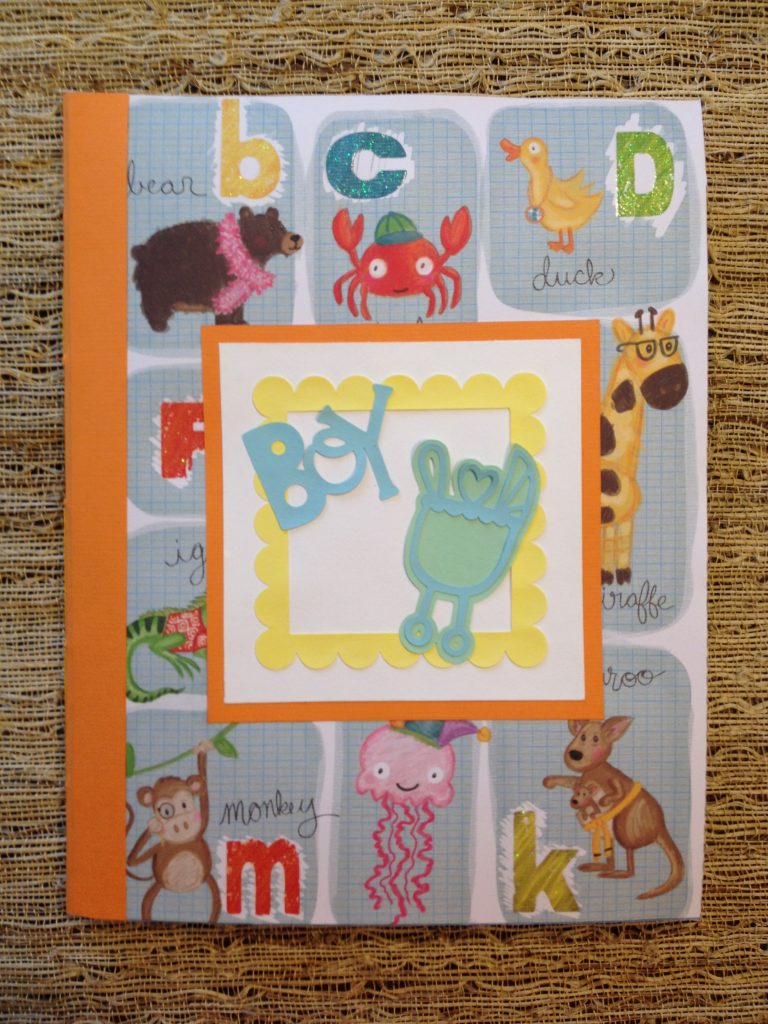
Front cover 
Page 1 
Page 2-3 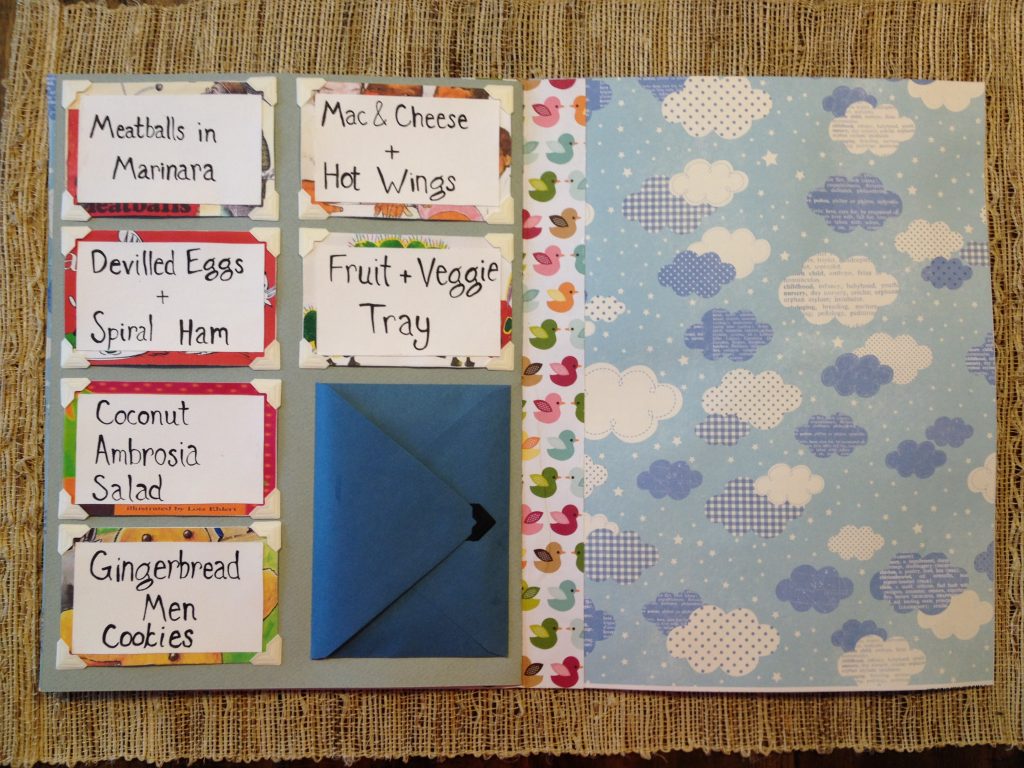
Page 4 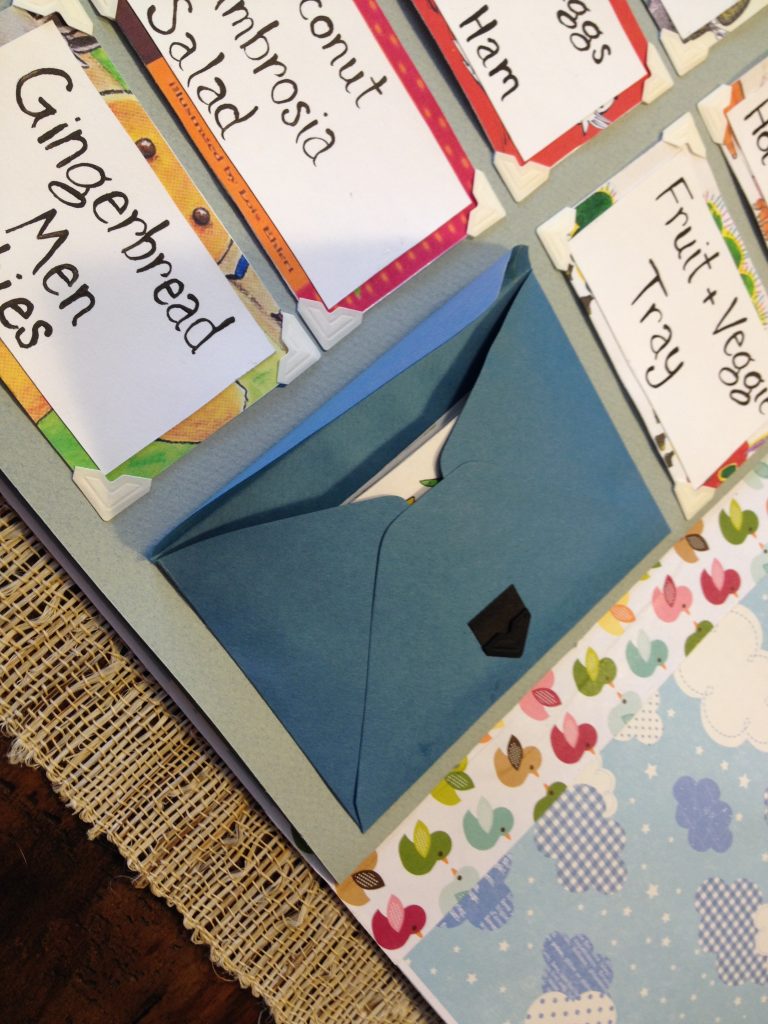
Envelope containing rest of food place cards
Michele also had a number of cards from the baby shower that she wanted to keep together, so she handed them over to me to experiment with. She didn’t request anything further than having them combined in some way that they would store together in a decorative way. Since she already had a box for the baby shower book (again, see post Baby Shower, vol. I), I thought it might be fun to have a more decorative binding that would make even the spine part of the display appeal. I bound all of the cards together using a Coptic stitch to create a sweet little book of well wishes for her to look back on. One of the cards was shaped as an air balloon, creating a gap right where the punch for the binding thread would go through, so I solved the problem by adding a paper insert of a coordinating color.

A quilled card made for a beautiful and dimensional front cover 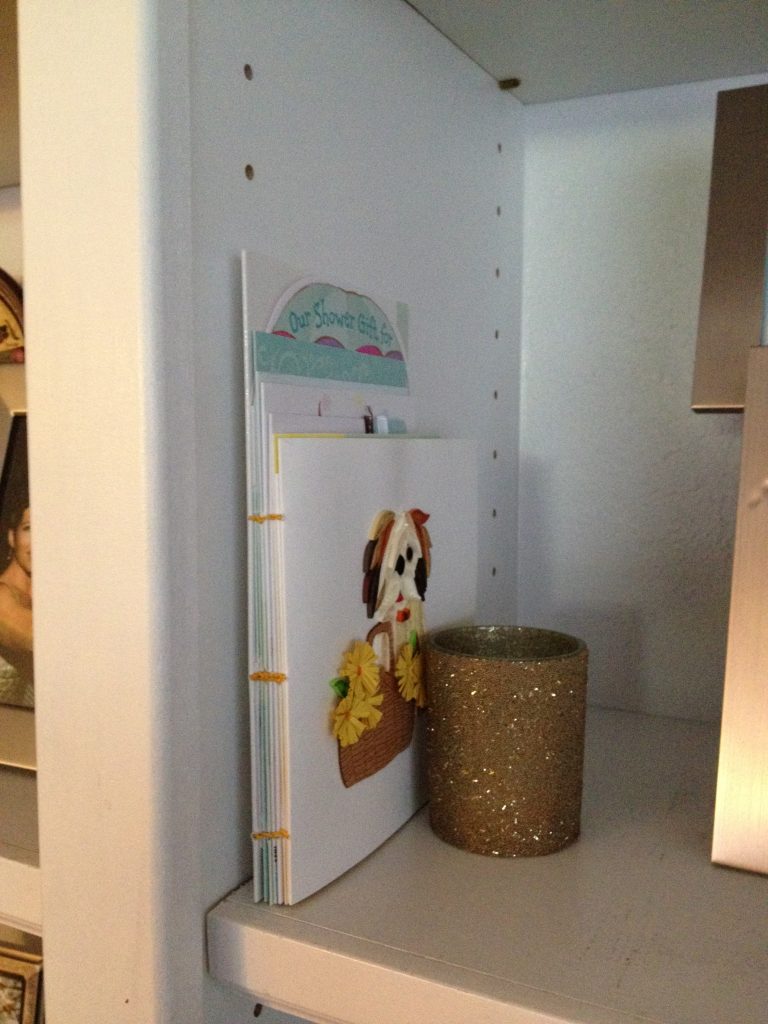
The book on display 
The fix on the air balloon card
The book arts present a fascinating mix of scholarship and craft in which artists and artisans both expand on traditional techniques and engineer solutions to novel problems. Humans display a persistent need to document their ideas in story-telling form: cave paintings, clay tablets, papyri scrolls, codices, artists’ books, and e-books. The evolution of these formats tracks the accumulated knowledge that book artists still employ today, explaining why scholarship is integral to the craft of book arts. As such, a core collection for book artists must include everything from encyclopedias to broad histories to technical texts in the format of videos, written tutorials, history books, catalogues of online resources, sample books, and binding equipment. This collection is intended to form a cohesive presentation of the resources and equipment necessary for a broad sampling of book artists, providing an accessible starting point for students and practitioners in their own research and collection building.
My senior year of undergrad, a library coworker introduced me to the book arts program at Wellesley College. It is composed of the ideal trifecta of departments: studio book arts, conservation and special collections. Katherine Ruffin heads the Book Arts Lab, Emily Bell the Conservation Lab, and Ruth Rogers & Mariana Oler the Special Collections. In the Book Arts Lab, we learned about equipment safety, typesetting and printing on Vandercook presses, historic and modern bindings, papermaking, and a general history of the book. Emily provided support for individual students on more in-depth projects beyond the scope of the introductory course. Special Collections provided a hands-on look at the implementation of book arts from the pre-print books to contemporary conceptual artists’ books. Over the course of this class, Katherine, Emily, Ruth and Mariana provided us with a number of essential resources, many of which I still seek out today. Unfortunately, the syllabus and handouts wandered off since graduation, so I lost track of the majority of those sources. After speaking with other practitioners, I’ve realized that many others also struggle to keep those lists in a safe, consistent form. My hope is that, because the collection I’ve put together is stored on a publicly accessible board on Pinterest, the Books Artists’ Core Collection will act as a practical means of tracking essential resources for book artists.
Book Arts & Book Artists
As I first learned from Wellesley’s Intro to Book Arts and have continued to experience, book artists and book historians display a considerable willingness to share their knowledge. This, I believe, is indicative of the apprenticeship nature of the book arts. While apprenticeship is a wonderful and necessary system of knowledge sharing, it complicates efforts at creating an authoritative collection of sources for the diverse artists that populate the discipline.
The book arts cover many branches of artistic creation, all of which are employed in the production of both artistic and functional materials. These branches include papermaking, letterpress printing, printmaking, calligraphy, illumination, binding, and digital media. Regional histories of the book, primarily divided into Western, Asian, and Middle Eastern, form the trunk for those branches.[1] Artists’ preference for either historic, traditional book arts or for novel book forms and practices form the roots. The ‘tree’ of book arts is far reaching and various. To create a core collection broad and deep enough to feed that tree, I chose to house the digital collection and catalogue on Pinterest.
Why Pinterest?
Pinterest is a global social media site that performs as a community “bookmarking tool that helps [its users] discover and save creative ideas.”[2] Pinners (users) can create boards on whatever topic they wish and pin relevant items of interest from the Internet to that board. By clicking the pin, users are directed back to the pin’s webpage of origin.[3] The real beauty of Pinterest, though, lies in its varied access points to the site’s communal knowledge gathering. Pinterest boasts several different searching options to engage with that knowledge community: (1) a keyword search function that seeks out pins either on your own boards or across the whole of Pinterest, (2) a browsing function that allows pinners to see pins related to a particular pin, (3) a browsing function that allows pinners to see boards related to a particular board, (4) a browsing function that allows pinners to see other boards on which a particular pin is pinned, and (5) a browsing function that allows pinners to see what else from a particular site has been pinned to Pinterest.
(1)

(2)

(3)

(4)

(5)

This sort of searching and browsing turns Pinterest into a highly linked catalogue and thesaurus. One pin can create an entire network of related items, which means that the Book Artists’ Core Collection acts as a jumping off point for practitioners to research more in-depth projects. For example, if an artist wishes to create a medieval book of hours, she can find the items in the core collection on parchment and papermaking, medieval bindings, paleography of the period, and illumination styles from various regions. Then once she determines the period and region she wishes to emulate, say a 14th century English binding, the artist can use those pins from the collection to seek out related items to provide further resources that are too specialized for the Core Collection, such as the saints that would have been significant to the region at the time or the plants and scenes most popularly illuminated, etc. Pinterest functions as an ideal means of creating a collection not limited by individual holdings, and thus not limiting those using the collection.
The Book Artists’ Core Collection board is also publicly available to anyone online with access to Pinterest. Having this core collection catalogue generally available helps combat the knowledge loss from misplaced handouts and course syllabi. Also, by storing the catalogue on Pinterest, users of the collection have not only easy browsing options, but also a simple means of accessing the online resources, such as the YouTube tutorials and samples of digital artists’ books. The major drawback of Pinterest as a platform for the collection lies in its lack of tagging. While I listed the subject headings in the description boxes for each pin, Pinterest has no function to search the collection by subject heading within the board, meaning that users have to scroll through the pins to locate items that might be of interest. While this is a major disadvantage, I felt that it was negligible compared to the advantages of the platform. Firstly, the collection is small enough that scrolling through is not too onerous, and two, it requires users to become familiar with the collection as a whole, thus introducing them to connections between resources that they might otherwise have missed.
The Collecting Process
My collecting process began with seeking out my old handouts and syllabus from Wellesley’s Intro to Book Arts course. Failing to locate those, I turned to the authorities in the discipline to orient me: the Center for the Book at the University of Iowa, the Book Arts Program at the University of Alabama, and the Rare Book School at the University of Virginia. Iowa and Alabama are renowned for the strength of their book arts studio programs and the Rare Book School (RBS) is internationally respected for its instruction in the study of the book arts and the history of the book. Like Wellesley College, the studio programs’ websites listed only course options, not course syllabi. From their course listings, I formed the structure of the Book Artists’ Core Collection:
- General History
- Papermaking
- Printing
- Calligraphy & Illumination
- Binding
- Digital Lab
- Equipment
My source for the resources under of each of these subject headings came almost exclusively from the RBS’s curriculum website, which does provide syllabi online for every course. I’m confident in the efficacy of these headings, since they are used as guiding themes by the Center for the Book, the Book Arts Program and the RBS, as well as my Wellesley course. I provide a breakdown of each subject heading in the sections below. Katherine and several other regional book artists also contributed noteworthy resources to supplement the thorough reading lists from the RBS. Though I depended primarily on RBS for hardcopy materials and select databases, the collection is still well rounded; the RBS hosts an extensive faculty of international scholars and experts in the study of book arts. By selecting a large cross-section of resources from the syllabi in all relevant subject areas, the Book Artists’ Core Collection remains broad and balanced. The tutorial videos channels from YouTube I selected from my own familiarity with the skills displayed, confirmed in their authority by aligning with the instructions given by well-respected authors in print. The equipment I chose from the most commonly needed items in a book arts studio that are not finite, and therefore reusable by multiple patrons for an indefinite period of time.
I chose not to emphasize the library science-oriented portion of the study of book arts because, while scholarship is necessary to the practice of book artists, information about collections management and analytical bibliography generally do not hold much relevance. I also didn’t include individual artists books in the collection because of the cost per book and because that sort of collecting is more within the sphere of special collections. The sole exception to this rule is Karen Hanmer’s Biblio Tech: Reverse Engineering Historical & Modern Binding Structures with a focus on board attachment (2013), which is meant as a teaching tool and provides such an array of binding structures that it is worth the investment. I instead included catalogues of artists’ books, ones that described binding styles, as well as more standard artwork metadata.
In the sections below elaborating on the subject headings, I have only included highlights from the collection to illustrate the sort of resources under that heading. While the collection is small enough to browse, it still contains 240+ items, most of which are fall under more than one heading due to the interdisciplinary nature of book arts. Therefore, listing them all under each heading would test any reader’s patience. Instead, I request that you visit the catalogue on Pinterest to examine the entirety of the collection.
General History
General history primarily contains the items that describe the historical development and evolution of various techniques in the book arts. For instance, Edo & Paris recounts the realities and depictions of early modern urban life and the state drawn from illustrated books from the period, allowing artists to see which styles were appropriate in which contexts and how they interacted with the codex form.[4]
This section also contains general knowledge, such as dictionaries and encyclopedias. I included these in this section because terms often developed and expanded over time, thus history can be read from the definition of terms. One example in the collection is the ABC of bookbinding: a unique glossary with over 700 illustrations for collectors and librarians. Though oriented towards library professionals and collectors, identification of terms from both text and image is key for book artists, particularly those new to the discipline.[5]
Papermaking
Papermaking, parchment making, and paper selection are all included under the Papermaking subject heading. This section includes instruction manuals, histories of writing surfaces and paper sample books. Japanese Papermaking: Traditions, Tools, and Techniques is representative of both the history texts and instruction manuals, since it goes through the historical techniques and their contexts in Japan. Sample books of both textblock and cover material are necessary to a core collection because it can be prohibitively expensive for individual artists to order sample books for each type of paper in which she’s interested. For instance, one company might have five lines of decorative papers, each of which have a sample book. Without actually interacting with the material, it can prove challenging for artists to select the appropriate papers just based on descriptions and a picture. Fine Papers at the Oxford University Press is representative of sample books, though it comes in a more traditional book form than many others.[6]
Printing
This subject heading includes both typography and illustrative printing. For the typography section of Printing, the collection primarily covers the development and history of typefaces and type design. For illustrative printing, the collection focuses on the identification of different kinds of printing methods and the use of illustrations in texts and ephemera. The printing section does not cover much instruction on the technical process of either branch of printing, since the knowledge needed changes for each press and since so many types of illustrative printing exist (e.g. drypoint and wood block). American Wood Type, 1828-1900 is representative of the typography portion of Printing. It follows the development, creation, dissemination and use of wood type in early-modern America. Another sort of typography resource includes those like graphic designer Marian Bantjes’ Ted Talk, in which Bantjes describes how graphic design and her individual style influences the way she depicts text.[7] The Picture Postcard & Its Origins is representative the ephemera section of illustrative printing, providing reference images for artists looking to create images of their own.[8]
Calligraphy & Illumination
Calligraphy & Illumination I incorporated together as a subject heading because they share many of the same tools and techniques and are often addressed together in book arts literature. Paleography, though, is the primary domain of Calligraphy, just as manuscript illumination is the primary domain of Illumination. Palaeography, 1500-1800: A Practical Online Tutorial from the National Archives represents the former and is one of several online tutorials that provide history, identification and execution as their focus.[9] Painted Prayers: The Book of Hours in Medieval and Renaissance Art represents the latter, as well as the former, displaying specimens from books of hours, the most common and highly illuminated genre extant from the medieval period.[10]
Binding
Binding, alongside Papermaking, serves as the most significant contribution to book arts technical skills offered by this collection. This subject covers both the history of binding styles and tutorials on replicating binding structures. Historically, much scholarship has been dedicated to analyzing the covers of books; Twelve Centuries of Bookbinding, 400-1600 is one of these texts that couches cover analysis within historical context.[11] The historical and technical is combined in Bookbinding Materials And Techniques, 1700-1920, in which the author couches technical innovations in its historical context.[12]
For book structures, both tutorials and models are essential. To provide models, I included Karen Hanmer’s Biblio Tech binding set, as mentioned in the section on The Collection Process.[13] Making Handmade Books: 100 Bindings, Structures & Forms provides instruction for various binding structures, both traditional and modern.[14]
Artists’ books also fall within this subject heading. As a form begun in the twentieth century, the discipline is still testing the bounds of what it means to create an ‘artist’s book.’ As Ruth phrased it when explaining her collecting process, “if it tells an engaging story in a novel way and it fits on the Special Collection’s shelves, it’s an artist’s book by my definition.” Essentially, though, an artist’s book is a work of art that interacts somehow with the storytelling aspect of a book structure. Johanna Drucker, in The Century of Artists’ Books, provides the most engaging overview of the artist’s book, situating it historically and stylistically, as well as examining its conceptualization.[15]
Digital Lab
The Digital Lab resources are the least developed part of the core collection. Because this is still such a new field in the grand scheme of book arts, a critical volume of resources has not yet developed. I included critical and technical resources, as well as some exhibition catalogues, to provide basic context, skills and examples of how artists are beginning to incorporate the digital into their practice. For the critical, I included The Abominable Digital Artists’ Book: Myth or Reality? by Esmée de Heer.[16] She defines the artist’s book and discusses the current status and potential future of digital technology in their creation. For skills acquisition, I included the Tate’s workshop on Transforming Artists Books, which links to the workshop reflections on skill sets and forms.[17] The best exhibition catalogue I encountered was Non-visible and Intangible, hosted by Hampshire College from 7-16 November 2012.[18] It shows the various stages at which digital technologies might integrate with more traditional forms, as well as how to make the digital form interactive in unexpected ways.
Equipment
As mentioned previously, I chose the equipment from personal observation of the most necessary items in a book artist’s toolbox that are not finite. Finite items—like paper, thread, and ink supplies—belong to the realm of art cages or studios rather than libraries. As such, the Book Artists’ Core Collection includes items like a travel kit of binding equipment, a sewing frame and a collapsible punching trough. These items can be repeatedly checked out by any number of users to supplement their own collections or help them get a feel for which styles or brands of equipment they most require.
[1] This particular breakdown of book arts was informed by the curriculum at both the University of Iowa Center for the Book and theBook Arts Program at University of Alabama.
[2] “Press.” About Pinterest. 2015.
[3] For more about using Pinterest, see the website’s promotional video.
[4] Henry D. Smith, II. “The History of the Book in Edo and Paris” in Edo and Paris: Urban Life and the State in the Early Modern Era. Edited by James L. McClain et al. Ithaca: Cornell University Press, 1994. Paperback, 1997. pp. 332-52.
[5]Jane Greenfield. ABC of bookbinding; a unique glossary with over 700 illustrations for collectors and librarians. New Castle, Carlton, 2002.
[6] Barrett, Timothy. Japanese Papermaking: Traditions, Tools, and Techniques. Colorado: Weatherhill, 1992; Bidwell, John. Fine Papers at the Oxford University Press. Whittington: Whittington Press, 1999.
[7] “Marian Bantjes: Intricate Beauty by Design.” Ted Talks. 2010.
[8] Kelly, Rob Roy. American Wood Type 1828 – 1900: Notes on the Evolution of Decorated and Large Types and Comments on Related Trades of the Period. New York: Da Capo Press, 1977; Staff, Frank. The Picture Postcard & Its Origins. New York: F.A. Praeger, 1966.
[9] “Palaeography, 1500-1800: A Practical Online Tutorial.” The National Archives. 2006.
[10] Wieck, Roger S. Painted Prayers: The Book of Hours in Medieval and Renaissance Art. New York: George Braziller, 1999.
[11] Needham, Paul. Twelve Centuries of Bookbindings, 400-1600. New York: Pierpont Morgan Library, 1979.
[12] Lock, Margaret. Bookbinding Materials and Techniques, 1700-1920. Toronto: Canadian Bookbinders and Book Artists Guild, 2003.
[13] Hanmer, Karen. Biblio Tech: Reverse engineering historical and modern binding structures. 2013.
[14] Golden, Alisa J. Making Handmade Books: 100 Bindings, Structures & Forms. New York: Lark Crafts, 2010.
[15] Drucker, Johanna. The Century of Artists’ Books. 2nd ed. New York: Granary Books, 2004.
[16] De Heer, Esmée. “The Abominable Digital Artists’ Book: Myth or Reality?” Universitiet Leiden: Masters Theses. 20 November 2012.
[17] “Transforming Artist Books.” Tate. August 2012.
[18] “About.” Non-Visible & Intangible. November 12, 2012.
Bibliography
“About.” Non-Visible & Intangible. November 12, 2012.
“About Pinterest.” Pinterest. 2015.
“Advance Reading Lists.” Rare Book School. 2015.
Barrett, Timothy. Japanese Papermaking: Traditions, Tools, and Techniques. Colorado: Weatherhill, 1992.
Bidwell, John. Fine Papers at the Oxford University Press. Whittington: Whittington Press, 1999.
“Curriculum | Book Arts.” Book Art @ Alamaba. University of Alabama. 2015
de Heer, Esmée. “The Abominable Digital Artists’ Book: Myth or Reality?” Universitiet Leiden: Masters Theses. November 20, 2012.
Drucker, Johanna. The Century of Artists’ Books. 2nd ed. New York: Granary Books, 2004.
Golden, Alisa J. Making Handmade Books: 100 Bindings, Structures & Forms. New York: Lark Crafts, 2010.
Grab, Elizabeth. “Book Artists’ Core Collection.” Pinterest. December, 2015.
Hanmer, Karen. Biblio Tech: Reverse engineering historical and modern binding structures. 2013.
Kelly, Rob Roy. American Wood Type 1828 – 1900: Notes on the Evolution of Decorated and Large Types and Comments on Related Trades of the Period. New York: Da Capo Press, 1977.
“List of Courses.” Center for the Book. University of Iowa. 2015.
Lock, Margaret. Bookbinding Materials and Techniques, 1700-1920. Toronto: Canadian Bookbinders and Book Artists Guild, 2003.
“Marian Bantjes: Intricate Beauty by Design.” Ted Talks. 2010.
Needham, Paul. Twelve Centuries of Bookbindings, 400-1600. New York: Pierpont Morgan Library, 1979.
“Palaeography, 1500-1800: A Practical Online Tutorial.” The National Archives. 2006.
“Press.” About Pinterest. 2015.
Staff, Frank. The Picture Postcard & Its Origins. New York: F.A. Praeger, 1966.
“Transforming Artist Books.” Tate. August 1, 2012.
Wieck, Roger S. Painted Prayers: The Book of Hours in Medieval and Renaissance Art. New York: George Braziller, 1999.
[Originally posted on Rambling Rambler Press @ WordPress on 9 December 2015]
]]>My topic guide, found at bookartsfoundationalresources.wordpress.com, presents a basic introduction to book arts knowledge, providing an accessible starting point and memory aide for students and practitioners of book arts and history of the book. Book artists connect with one another online, through collaborative works, or workshops. Book historians often relegate themselves to historical observation and conferences. The two communities overlap occasionally at workshops—typically through the Rare Book School—so they share a basic vocabulary. Even with the proliferation of these and other communities centered on book arts, however, it’s challenging to locate centralized information that covers all of the aspects of the art.
Book arts encompass many interdisciplinary branches of craft; relevant branches include binding, calligraphy and illumination, conservation and preservation, digital media, history, papermaking, and printing. To explore the forms expressed in book arts, one needs access to materials from print encyclopedias to technical videos. The collection from which I’m selecting includes all online (primarily free) materials concerning the branches of book arts and suggestions made by book artists and art librarians in my acquaintance. I prioritized illustrated resources with an eye towards application. For example, I selected the Advance Reading Lists from the Rare Book School, which provides online subject-specific reading lists for 80+ courses. The scope includes bookbinding, bibliography, history of the book, illustration & printing processes, manuscripts, and typography & book design covering 800AD – 21st century. I also selected items like John Carter’s ABC for Book Collectors. This illustrative dictionary covers technical, historical and contemporary book terms from 15th century – 2004. It is available online as a PDF.
Edits made after presenting a draft of the site to the class
After presenting to the class, Stephanie directed us to link items only when they were available online. This forced me to realize that narrowing the print collection to any physical collection, and therefore to a geographic location, didn’t allow the coverage needed to best serve the book arts community (originally I had also been pulling from UNC’s libraries). Most practitioners and historians locate their materials online, making geographic limiters arbitrary. The presentation, friends’ comments and INLS501’s emphasis on avoiding superfluous information informed my choices. The design is spare and I narrowed the home page to the necessities, gutting a section on access and eliminating the section on navigation. I focused on placing visual cues like links, bullets, and images in key areas.
Because of the interdisciplinary nature of most of the resources, I decided against individual posts themed around a book arts branch, since the additional scrolling and more complicated navigation scheme negate the virtue of tagging. Instead, I identified each column as traditional or contemporary, a division more pertinent to my audience than disciplinary splits.
For audience preference and because of the digital comfort levels displayed in INLS501’s examples, my tabs divide print and electronic resources; many in the community operate online, but sometimes the physical offers advantages like concrete ownership and the ability to mark up the text. Based on presentation suggestions, I simplified the resource descriptions and removed unnecessary buttons. I also made other changes, like adding a pipe symbol to delineate between the other buttons, avoiding jargon and enabling white space.
Creating this guide displayed the effort required for instruction, making me reconsider performance and assessment metrics while indulging my drive to disseminate information and introducing me to a fascination with HTML.
In the future, I will find the code to enable more white space between the columns. I also plan to add tabs for topics such as ‘Related Topic Guides’ and ‘Book Arts Organizations’
]]>